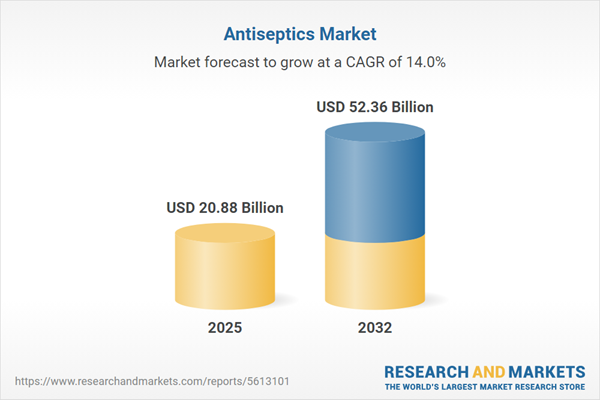Speak directly to the analyst to clarify any post sales queries you may have.
The antiseptics market is rapidly evolving as organizations prioritize infection prevention, streamline procurement strategies, and strengthen compliance frameworks to enhance supply chain resilience.
Market Snapshot: Antiseptics Market Size, Growth, and Strategic Developments
The global antiseptics market is projected to expand from USD 18.35 billion in 2024 to USD 20.88 billion in 2025, achieving a compound annual growth rate (CAGR) of 13.99%. This growth is underpinned by escalating infection control requirements, expanding clinical uses, and continuous progress in antimicrobial technologies. Regulatory changes and evolving healthcare delivery models are influencing operational planning and procurement, pushing organizations to adopt strategies that prioritize compliance and flexibility. Adaptability remains a central factor for market competitiveness as innovation and policy dynamics continue to reshape the industry landscape.
Scope & Segmentation: Comprehensive Overview of Key Antiseptics Market Segments
- Product Types: Includes alcohol-based foams, gels, solutions, sprays, biguanides, chlorhexidine, hydrogen peroxide, iodine-based products, phenolic compounds, and quaternary ammonium compounds. These address a spectrum of clinical and hygiene needs, each aligning with recognized infection control protocols and tailored to local regulatory criteria.
- Formulations: Covers foams, gels, solutions, sprays, and wipes, enabling flexible deployment across care environments while supporting practical handling, safety, and suitability for both healthcare and consumer applications.
- Applications: Encompasses instrument disinfection, surgical site preparation, wound care, hand hygiene, and surface cleaning, demonstrating the category's versatility and critical role in supporting infection control efforts in both professional and private settings.
- End Users: Spans hospitals, clinics, ambulatory surgical centers, veterinary facilities, and home care providers, all relying on robust antiseptic solutions to maintain safety and regulatory compliance throughout care delivery processes.
- Distribution Channels: Incorporates retailers, in-hospital pharmacies, online pharmacies, specialized e-commerce platforms, and integrated procurement networks. These channels supply institutional and commercial buyers efficiently, meeting diverse and evolving needs.
- Packaging Types: Consists of aerosol cans, sachets, bottles, and single-use wipes, all designed for ease of use and adherence to hygiene standards, meeting varied requirements across user groups and environments.
- Regions: Divided into the Americas, Europe, Middle East & Africa, and Asia-Pacific. Each region offers unique growth opportunities shaped by healthcare infrastructure, demographic factors, and regulatory differences. Major markets such as the United States, Germany, China, and India strongly influence trends and adoption rates.
- Leading Companies: Features prominent names such as Reckitt Benckiser Group plc, Ecolab Inc., 3M Company, Johnson & Johnson Services, Inc., STERIS plc, B. Braun Melsungen AG, Ansell Limited, Mölnlycke Health Care AB, Cardinal Health, Inc., and Paul Hartmann AG, each advancing market access and driving the uptake of cutting-edge infection prevention solutions.
Key Takeaways: Strategic Insights for Senior Decision-Makers
- Implementing sustainability-focused procurement is helping organizations enhance environmental performance, operational credibility, and supply chain robustness.
- Innovations such as plant-derived ingredients and encapsulation technologies are fostering transparency and strengthening end-user confidence in product safety.
- Regional procurement and production approaches are being adopted, providing agility in responding to shifting market or policy conditions and enhancing overall resilience.
- The use of predictive analytics in manufacturing and logistics is improving process efficiency, identifying potential risks in real time, and supporting continuous improvement initiatives.
- Companies are benefiting from multi-channel distribution strategies, which allow for rapid adaptation to changing demand patterns and enable flexible fulfillment models across established and emerging markets.
Tariff Impact: Navigating U.S. Trade Developments
Recent and anticipated U.S. tariffs are prompting antiseptics manufacturers to adjust cost structures and sourcing strategies. The shift toward localized production and strengthened regional supply chains is helping mitigate risks tied to fluctuating global trade conditions, supporting stable business operations and reliable supply continuity.
Methodology & Data Sources
This research leverages expertise from infection control specialists, supply chain analysts, in-depth literature reviews, and regulatory assessments. Patent analysis provides a benchmark for current technologies, ensuring the insights address the needs of senior executives in the antiseptics sector.
Why This Report Matters
- Delivers clear segmentation and actionable market intelligence designed to guide strategic decision-making and performance benchmarking for executive stakeholders.
- Identifies operational and supply chain challenges, offering frameworks for innovation and partnership to secure business continuity and growth opportunities.
- Equips organizations to anticipate regulatory changes, supporting agile compliance and timely technical advancements while strengthening competitive positioning.
Conclusion
Success in the antiseptics market depends on prioritizing compliance, sustainable practices, and operational adaptability. Embracing digital transformation and decisive leadership will shape continued relevance and resilience amid evolving industry challenges.
Additional Product Information:
- Purchase of this report includes 1 year online access with quarterly updates.
- This report can be updated on request. Please contact our Customer Experience team using the Ask a Question widget on our website.
Table of Contents
3. Executive Summary
4. Market Overview
7. Cumulative Impact of Artificial Intelligence 2025
Companies Mentioned
The companies profiled in this Antiseptics market report include:- Reckitt Benckiser Group plc
- Ecolab Inc.
- 3M Company
- Johnson & Johnson Services, Inc.
- STERIS plc
- B. Braun Melsungen AG
- Ansell Limited
- Mölnlycke Health Care AB
- Cardinal Health, Inc.
- Paul Hartmann AG
Table Information
| Report Attribute | Details |
|---|---|
| No. of Pages | 187 |
| Published | October 2025 |
| Forecast Period | 2025 - 2032 |
| Estimated Market Value ( USD | $ 20.88 Billion |
| Forecasted Market Value ( USD | $ 52.36 Billion |
| Compound Annual Growth Rate | 13.9% |
| Regions Covered | Global |
| No. of Companies Mentioned | 11 |









